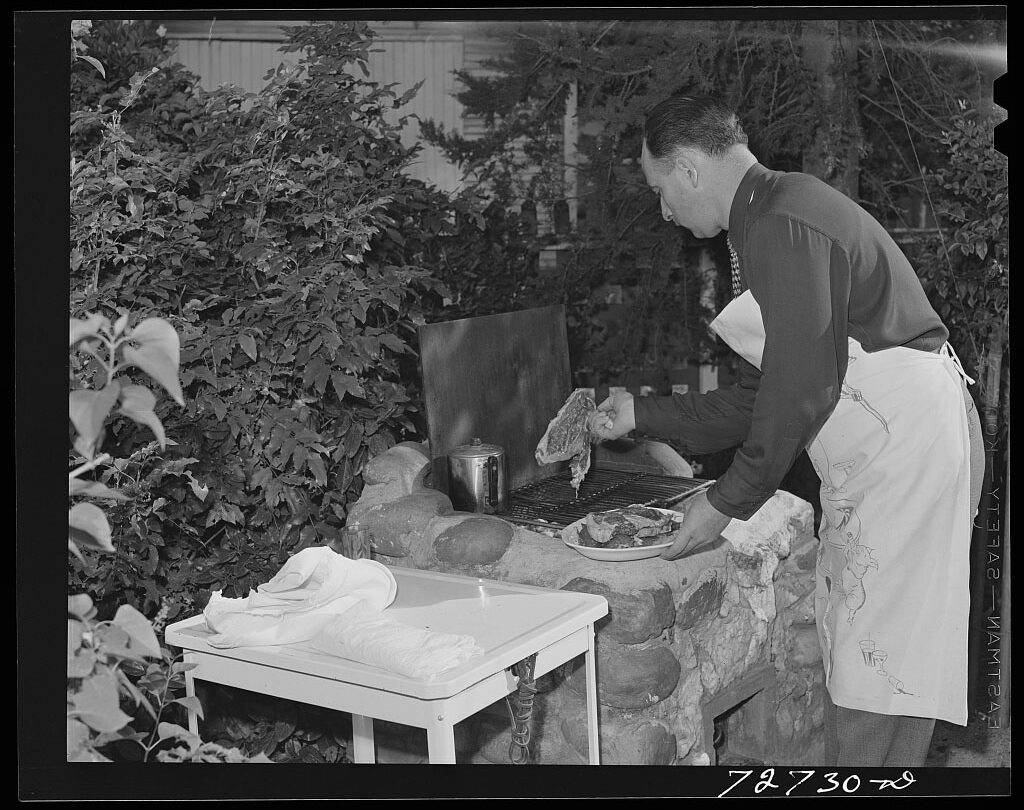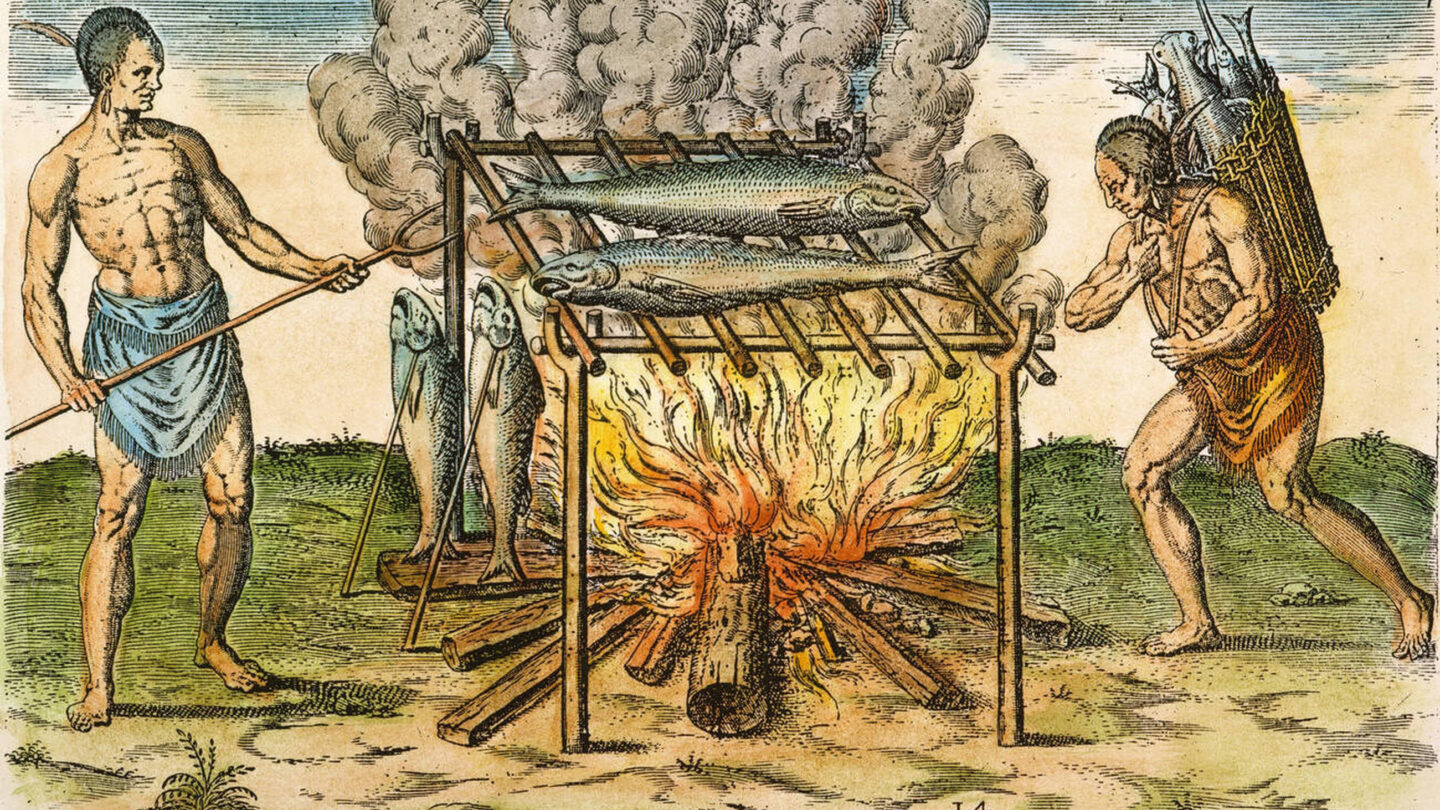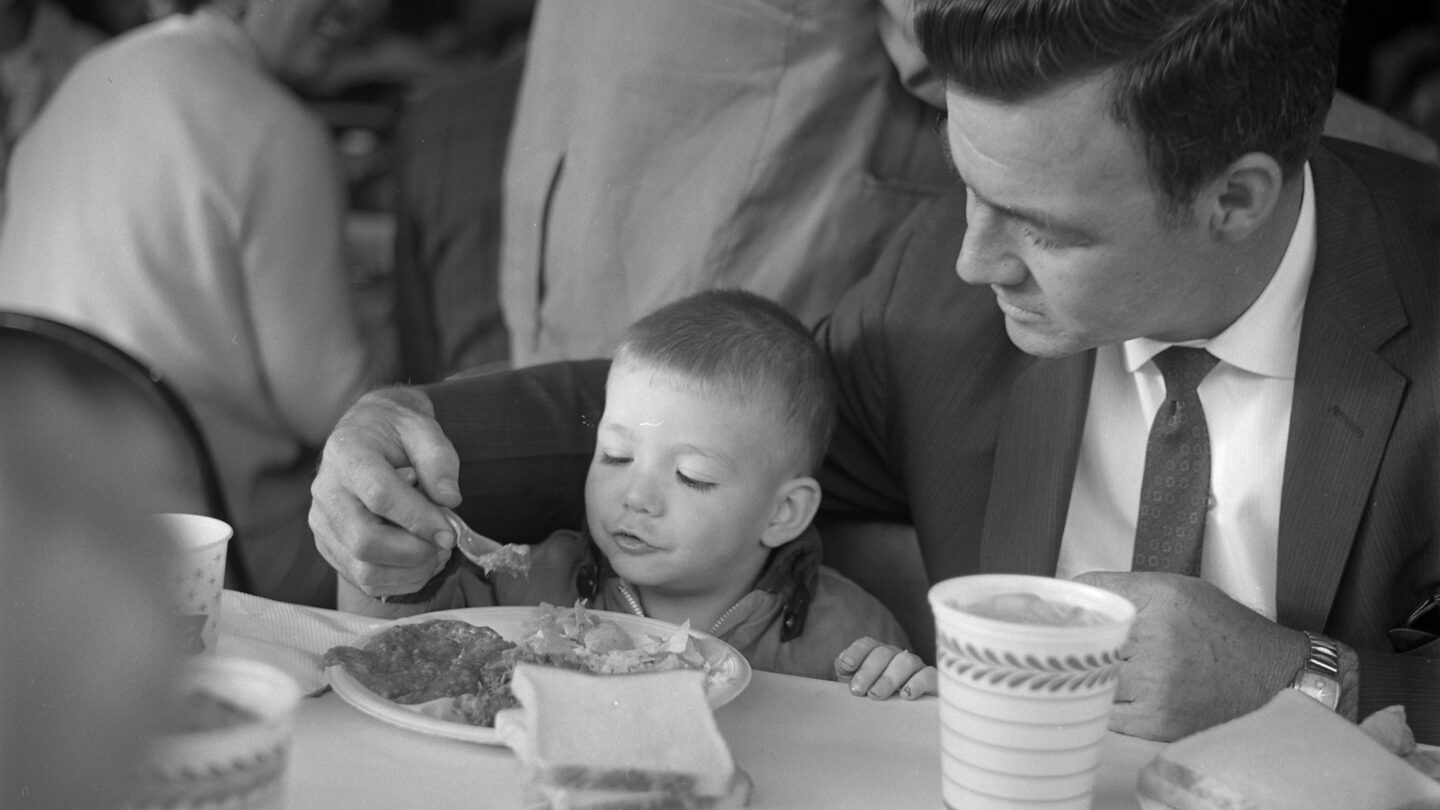
A man barbecues steaks over an open grill in his backyard in Turlock, California, 1942. Russell Lee, Library of Congress.
When some people picture an American family enjoying barbecue, they might see a grinning father working over a fiery pit in his picket-fenced backyard. Children play outside, enjoying the hot summer day, while their mother prepares side dishes in the air-conditioned kitchen. This image of a wholesome family meal seems harmless, but it reveals many assumptions about American barbecue culture. Why do people assume the father grills the meat and the mother handles everything else in the kitchen? And how many imagine this “all-American” family as white and middle class? Lastly, die-hard barbecue fans would note that this description is grilling, not barbecuing.

Colored engraving of Native Americans broiling fish, 1590. Theodor de Bry
Origins and Evolution
Indigenous Americans have used smoke to cook meat for more than 10,000 years. While traditions vary, some used a framework of sticks to hold food above a smoldering fire. The Taino people of the Caribbean called this structure a brabacot. In West Africa, the Hausa people used the term babbake to describe cooking food over an open fire. They roasted pork and chicken, seasoning them with black pepper, cloves, and other spices. Today, you can still find cooking methods inspired by babbake in Senegal, Ghana, Nigeria, and Cameroon. As European explorers encountered African and Indigenous culinary traditions, they adopted them into their own cuisines. The Spanish translated babbake and brabacot as barbacoa, while the French referred to the same methods as boucan. The word “barbecue” appeared in English in 1688, and 50 years later, the first barbecue recipe appeared in a British cookbook. Edward Ward’s The Barbacue Feast: Or the Three Pigs of Peckham published in 1707 was the first known use of the term to refer to a public gathering that served meat that was cooked outdoors on a rack over an open fire.
Barbecue’s Roots and Evolution in America
When West Africans came to the Americas, they brought with them their culinary traditions including babbake. As they adapted to a new environment, African Americans also borrowed culinary traditions from local Indigenous tribes. These traditions may have included Indigenous-style barbecue.
The first recorded mention of barbecue in the United States comes from John Lederer’s travel writings, published in 1672. Lederer was a pioneer explorer of the Virginia Blue Ridge and Carolina Piedmont regions.
George Washington attended an ox barbecue on September 18, 1793, celebrating the laying of the U.S. Capitol cornerstone. In 1955, Allyn Cox depicted this event in a mural on the Washington Masonic National Memorial. Cox’s depiction featured only white men and women, erasing the enslaved Black labor that built the cornerstone and cooked the barbecue for the celebration.
“Barbecue, Atlanta Exposition” The New York Public Library Digital Collections. 1896.
During the antebellum period in the United States, most groups enjoyed barbecue. White slave owners were served barbecue, and poor white Southerners learned to barbecue because they were also given undesirable portions of meat. Barbecue’s cooking methods were established out of necessity for enslaved Black people, who were forced to subsist on lesser cuts of meat while the more desirable parts were reserved for their enslavers. They barbecued animal ribs, feet, knuckles, and other entrails to make them more palatable. Without the race and class-based limits on Southerners’ diets, people likely would have never begun eating ribs and ham hocks in the U.S.
Barbecue traditions migrated alongside African Americans in the United States. Enslaved Black people and their enslavers brought barbecue pork to eastern Texas. When the Great Migration began in the early 20th century and millions of Black people traveled to northern cities in the United States, they took their barbecue traditions with them, spreading them beyond the American South for the first time. Across America, barbecue traditions are specific to each region, from Texas to Chicago. While these traditions are inspired by regional history, one thing is clear: without the presence of African Americans, barbecue would have never taken off in the United States.

An adult and child enjoy barbecue during a Southern Railway Family Days event in Birmingham, Alabama. Southern Railway Photographs, Kenan Research Center at Atlanta History Center
Modern Perceptions and Misconceptions
How did American barbecue, with its origins in disenfranchised Black communities, come to be associated with privileged white men? This can be attributed to the erasure of enslaved Black labor, as evidenced by Cox’s mural. Even after emancipation, white hosts of barbecue events were often credited as the “pitmasters,” even if Black barbecue chefs catered the event. One example is the 1895 Cotton States and International Exposition in Atlanta, where the efforts of Black barbecue chefs were attributed to the white Sheriff John Callaway.
The whitewashing of barbecue continued when it transitioned from a symbol of the broader community to a marketed commodity in the 20th century. When the U.S. highway system was first established, restaurants and gas stations sprouted along its roads. In the South, these rest stops often served barbecue. The first roadside barbecue restaurants were family-owned businesses like J.R.’s Family Bar-B-Q, Hobgood’s Family BBQ, and Jack Cobb & Son Bar-B-Q. Even McDonald’s, when it was a small San Bernadino, California, restaurant owned by two brothers, primarily served barbecue. The market potential of barbecue could no longer be denied, and by the 1920s, people were building franchises and brands around it. As a result, barbecue became associated with quick consumption instead of slow cooking and communal gatherings.
The Pig & Chick restaurant and Blanchard Brothers Funeral Home on Peachtree Street. Arthur S. Montgomery Photographs, Kenan Research Center at Atlanta History Center
In the early 1920s, barbecue entered the suburbs when the Ford Motor Company began selling charcoal briquettes, making grilling easier for those who couldn’t make lump charcoal from hardwood. George Stephen’s invention of the Weber kettle grill in 1952 further popularized backyard grilling. Before the mid-20th century, barbecue was associated with holidays and large community gatherings, especially in the African American community. Charcoal briquettes and domed backyard grills signaled a new tradition of eating barbecue at home with family. When cookbooks featuring guides to making barbecue entered the market, they catered to white men in privileged communities. These cookbooks reinforced gender roles by associating men with the “dangerous” task of pitmaster, while women were relegated to the kitchen, making “safer” side dishes. As American barbecue advertising continued to cater to the most privileged people, its roots in Black and Indigenous American traditions were left further behind.
People in a barbecue buffet line during a Southern Railway Family Days event in Birmingham, Alabama. Southern Railway Photographs Kenan Research Center, Atlanta History Center
It wasn’t until the latter half of the 20th century that American barbecue’s origins were revisited, driven by the rising interest in traditional “slow-cooked” barbecue in the 1980s and 1990s. Barbecue competitions also gradually increased the diversity of their participants, including women, African Americans, Latinos, and international chefs. Despite this, the pervasive image of a white suburban father cooking barbecue for his stay-at-home wife and children remains in the cultural zeitgeist.
As you enjoy your barbecue this summer, take pride in the fact that you are partaking in an all-American tradition—not because it has anything to do with patriotism, but because the history of barbecue mirrors the diversity that makes up our great melting pot.

